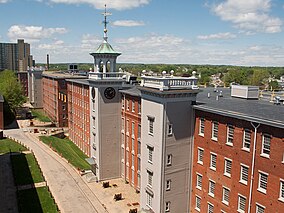Lowell National Historical Park
| Lowell National Historical Park | |
|---|---|
|
IUCN category V (protected landscape/seascape)
|
|

The Boott Cotton Mill & Museum
|
|
| Location | Lowell, Massachusetts, United States |
| Nearest city | Lowell, Massachusetts |
| Coordinates | 42°38′48″N 71°18′37″W / 42.64667°N 71.31028°WCoordinates: 42°38′48″N 71°18′37″W / 42.64667°N 71.31028°W |
| Area | 141 acres (57 ha) |
| Established | June 5, 1978 |
| Visitors | 520,452 (in 2011) |
| Governing body | National Park Service |
| Website | Lowell National Historical Park |
Lowell National Historical Park is a National Historical Park of the United States located in Lowell, Massachusetts. Established in 1978 a few years after Lowell Heritage State Park, it is operated by the National Park Service and comprises a group of different sites in and around the city of Lowell related to the era of textile manufacturing in the city during the Industrial Revolution. In 2019, the park is scheduled to be included as Massachusetts' representative in the America the Beautiful Quarters series.
First settled by Europeans in the 17th century, East Chelmsford (later renamed Lowell in honor of the founders' deceased business partner) became an important manufacturing center along the Merrimack River in the early 1820s. It was seen as an attractive site for the construction of a planned industrial city, with the Middlesex Canal (completed in 1803) linking the Merrimack to the Charles River, which flows through Boston, and with the powerful 32' Pawtucket Falls. The already existent Pawtucket Canal, designed for transportation around the Pawtucket Falls on the Merrimack, became the feeder canal for a 5.6-mile long system of power canals based around the falls. Unlike many other mill towns, however, Lowell's manufacturing facilities were built based on a planned community design. Specifically Lowell was planned as reaction to the mill communities in Great Britain, which were perceived as cramped and inhumane. Initially the factories of Lowell were built with ample green space and accompanying clean dormitories, in a style that anticipated such later architectural trends as the City Beautiful movement in the 1890s. Lowell attracted both immigrants from abroad and migrants from within New England and Quebec (including a large proportion of young women) who lived in the dormitories and worked in the mills.
...
Wikipedia

